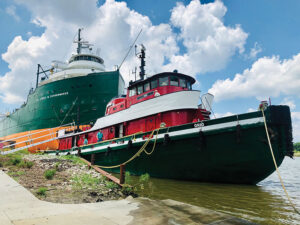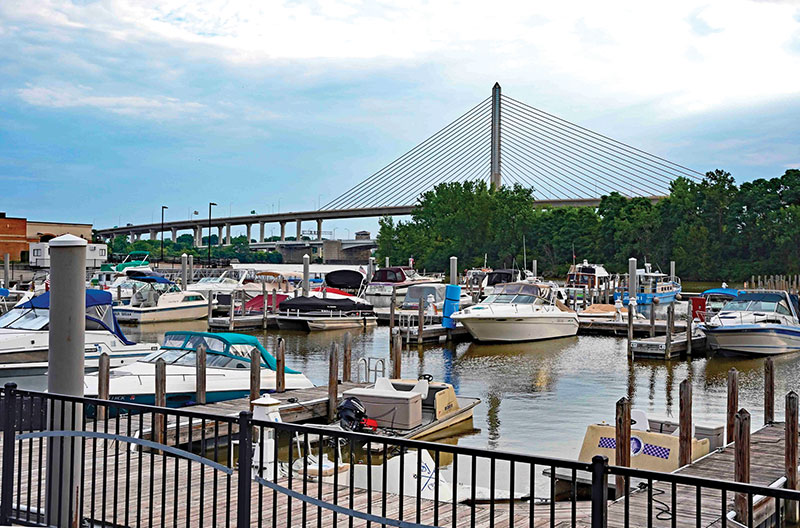Photo by Toledo Aerial Media
A boatload of attractions — including the nation’s largest mural — along the Maumee make Toledo a mighty fine Lake Erie destination.
Despite all the natural assets that Toledo, Ohio, enjoys because of its location at the place where the gaping mouth of the Maumee River empties into an eponymous bay, something man-made is making waves in western Lake Erie’s predominant port city. The largest mural in the United States — the Glass City River Wall (GCRW) — measures 170,000 square feet and covers 28 silos at an ADM grain terminal. Stretching for about 900 feet along the river’s east side, the 135-foot-tall silos form a colossal concrete canvas for larger-than-life images of flamboyant sunflowers, stunning blue skies and Native American likenesses that honor the indigenous people who first farmed the land in what is now Ohio’s northwest corner.
Although GCRW is, well, elevating Toledo tourism, its earliest fans were boaters who loved circling in front of the silos to honk their horns and shout encouragement to the painters working in boom man lifts high above the water. In fact, GCRW is such a monumental attraction that even before it was finished, J&M Cruise Lines, which also operates downtown Toledo’s water taxi, began offering excursions to the mural on its sightseeing vessel, The Sandpiper.
History abounds
Long before tour boats plied the Maumee, of course, the area was populated by Native Americans who built villages, planted crops and traversed its waters in birch bark canoes. After the Revolutionary War, Americans’ growing hunger for native lands in the Ohio Territory triggered bloodshed and atrocities that culminated in 1794 on a battlefield, Fallen Timbers, that is now preserved as a Metroparks Toledo site. Commanded by General Anthony Wayne, the fledgling Legion of the United States decisively defeated a British-backed coalition of tribal warriors. In the subsequent peace treaty, which was signed in modern-day Greenville, Ohio, the Indians effectively relinquished the Ohio Territory, instigating a flood of settlers who spawned the Great Lakes states of Ohio, Indiana, Illinois, Michigan, Wisconsin and Minnesota.
To stem the tide of America’s westward expansion, the Ohio-born Shawnee chief Tecumseh joined forces with the British during the War of 1812. When the U.S. Navy trounced a British fleet in the Battle of Lake Erie, the victory gave America control of Lake Erie and led to another British defeat — as well as Tecumseh’s death — at the Battle of the Thames in Canada. The war ended in a stalemate for Britain and the United States, but Native Americans lost any hope of retaining their homelands in the Great Lakes region, whose rich resources, farms and factories would stoke America’s transformation from upstart nation to economic powerhouse.
In 1833, two villages on the Maumee merged to form a town that its citizens christened Toledo, supposedly because the name was easy to pronounce and rarely used in the United States. Toledo was tiny but had enormous potential for growth, thanks to its favorable geography and the new Miami and Erie Canal, an artificial waterway that once transported goods and people from Cincinnati to Toledo. The “Toledo Strip,” which included the budding city and hundreds of square miles of fertile farmland, was considered such prime real estate that both Ohio and the Michigan Territory claimed it.
Their border dispute came to a head in 1835, when Ohio and Michigan launched the Toledo War by sending its militias to the contested area. Congress ended the largely bloodless conflict by awarding the “Toledo Strip” to Ohio. In compensation, Michigan got its Upper Peninsula and statehood two years later. The two states then continued to spar over their Lake Erie boundary until 1973, when the Supreme Court finally decided the matter. As a result, many contend that the intense college football rivalry between Ohio State’s Buckeyes and Michigan’s Wolverines originated with the Toledo War.
Holy Toledo!
Today, Toledo is a city of about 270,000 that seems to effortlessly combine a certain small-town friendliness with big-city attractions born out of its strong manufacturing heritage. At the turn of the last century, pioneering glassmaker Edward Libbey and his inventive protégé Michael Owens turned Toledo into the “Glass Capital of the World.” During World War II, the city also became the home of the Jeep, the iconic “GP” (general purpose) military vehicle and symbol of American ingenuity. Toledo now produces the Jeep Wrangler and Jeep Gladiator, and every August, the city celebrates its incomparable connection to the brand with Jeep Fest, a three-day event that attracts Jeep aficionados from around the world and features an all-Jeep parade through downtown Toledo.
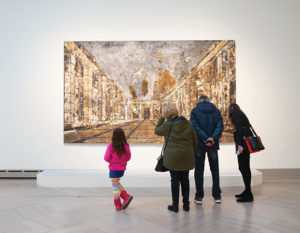 Libbey Glass still has its headquarters and tabletop glassware plant in Toledo, and the Libbey Factory Outlet in the city’s historic Erie Street Market is a mecca for bargain hunters. Edward Libbey’s greatest Toledo legacy, however, is the world-class art museum that he and his wife, Florence, founded to benefit the city. “The Toledo Museum of Art,” notes veteran tour guide Mary Galvin, “is truly the gem of Toledo, and because of the Libbeys’ philanthropy, it’s free to the public.” The Libbeys personally acquired the museum’s first work of art — a 3,500-year-old mummy’s coffin — during a 1906 trip to Egypt, and Galvin delights in showing visitors the exhibit’s photo of Edward and Florence riding on camels.
Libbey Glass still has its headquarters and tabletop glassware plant in Toledo, and the Libbey Factory Outlet in the city’s historic Erie Street Market is a mecca for bargain hunters. Edward Libbey’s greatest Toledo legacy, however, is the world-class art museum that he and his wife, Florence, founded to benefit the city. “The Toledo Museum of Art,” notes veteran tour guide Mary Galvin, “is truly the gem of Toledo, and because of the Libbeys’ philanthropy, it’s free to the public.” The Libbeys personally acquired the museum’s first work of art — a 3,500-year-old mummy’s coffin — during a 1906 trip to Egypt, and Galvin delights in showing visitors the exhibit’s photo of Edward and Florence riding on camels.
Its encyclopedic collections also include a portrait of the hero of the Battle of Lake Erie — Commodore Oliver Hazard Perry — by Gilbert Stuart, an artist whose work Americans see every day because he also painted the picture of George Washington that appears on the dollar bill. Since Stuart habitually left paintings unfinished, his daughter Jane completed the Perry portrait after his death. Not surprisingly the museum’s glass collection is dazzling, and its Art Glass Pavilion contains a hot shop where you can watch glass blowers at work.
The art museum’s campus anchors Toledo’s Old West End, where wealthy Toledoans built so many elaborate homes that it now constitutes one of the nation’s largest Victorian and Edwardian neighborhoods. According to legend, the Old West End churches congregated on Collingwood Avenue also inspired the expression, “Holy Toledo!” Arguably the most impressive of those churches is Our Lady, Queen of the Most Holy Rosary Cathedral, whose grand — and rare — Spanish Plateresque architecture gives a nod to Toledo’s sister city, Toledo, Spain. Remarkably enough, the cathedral was constructed during the Depression, and if you schedule a guided tour of the interior, you’ll learn that its exquisite Rose Window was financed with pennies donated by children.
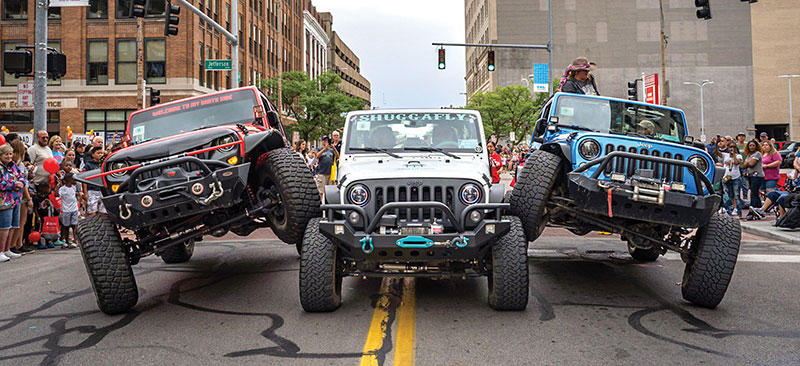
Photo Courtesy Jeepfest Facebook
Above Photo Courtesy of Destination Toledo
Photo Courtesy Metroparks Toledo
Be our guest
Toledo boasts the largest seaport by area on the Great Lakes, and its shipping channel extends several miles upriver from Maumee Bay to just beyond the GCRW. Marine facilities and freight terminals for corn, soybeans, wheat, iron ore, coal, cement and petroleum products flank both sides of the riverfront; however, because the Maumee is also a playground for pleasure boaters, smaller boats routinely share its waters with the massive freighters that give Toledo a global reach.
At the mouth of the Maumee, three yacht clubs — Bay View, Toledo and Harbor View — provide guest dockage to I-LYA and AYC members and allow easy access to the river as well as the open waters of Lake Erie and destinations such as Sandusky, Put-in-Bay and Kelleys Island. East of the city along the lakeshore, Cooley Canal is an Army Corps of Engineers-designated Harbor of Refuge, where Anchor Point Marina and Meinke Marina welcome transient boaters and have amenities that include, respectively, a waterfront restaurant and campsites with docks. In addition, Cooley Canal Yacht Club offers reciprocal I-LYA and AYA docks and hosts a June regatta that dates to the 1950s.
 A 20-minute Uber or taxi ride away from downtown Toledo, Maumee Bay State Park possesses recreation options that range from hiking, biking and birding trails to a Scottish links golf course to a marina with day-use and overnight slips. The marina is practically next door to Maumee Bay Lodge & Conference Center, and boaters staying over at the marina get to use all the niceties available at the Lodge, including restaurants and an indoor and outdoor swimming pool. You can even arrange for a golf cart, and catering manager Amy Boyer says, “We’ll also supply prepared food, snacks and beverages to our boating guests.”
A 20-minute Uber or taxi ride away from downtown Toledo, Maumee Bay State Park possesses recreation options that range from hiking, biking and birding trails to a Scottish links golf course to a marina with day-use and overnight slips. The marina is practically next door to Maumee Bay Lodge & Conference Center, and boaters staying over at the marina get to use all the niceties available at the Lodge, including restaurants and an indoor and outdoor swimming pool. You can even arrange for a golf cart, and catering manager Amy Boyer says, “We’ll also supply prepared food, snacks and beverages to our boating guests.”
Another bonus of the state park’s marina is its proximity to both the Oregon Inn, which sits just outside the park, and Tony Packo’s Café, an east Toledo institution that has been serving Hungarian-American foods since the 1930s. While the Oregon Inn is known for its “Mile High Meatloaf” and generous portions of Lake Erie walleye and perch, Toledo native Jamie Farr (a.k.a. Corporal Klinger) made Tony Packo’s hot dogs famous by touting them on the TV sitcom “M*A*S*H.” For decades, celebrity diners from actor Burt Reynold to President George W. Bush have been signing their names on Tony Packo’s hot dog buns, and hundreds of replicas of those autographed buns hang inside the restaurant, forming an only-in-Toledo hall of fame that customers like to admire after finishing their chicken Paprikash or roast beef on rye with Hungarian gravy.
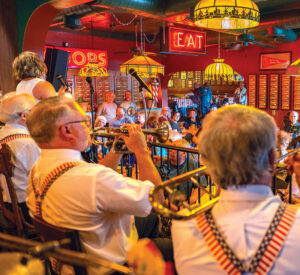 Riverfront resurgence
Riverfront resurgence
In recent years, Toledo has experienced a riverfront resurgence that has enlivened the central city and ramped up its appeal — and accessibility — to boaters. You’ll find city-owned public docks in both downtown Toledo’s Promenade Park (reserve a slip at jmcruiselines.com/dock-masters) and across the river at The Docks, an east side smorgasbord of dock-and-dine restaurants — think Zia’s Italian, El Vaquero Mexican, the Real Seafood Company — with a verdant setting in International Park and waterfront patios that are fine places to watch the setting sun reflect off the river and city’s skyline.
Although Promenade Park affords a convenient gateway to attractions such as the Maumee Bay Brewing Co. and Hensville, an entertainment district where the Toledo Mud Hens play Triple-A baseball, it’s also a destination in its own right. Throughout the summer, the park’s outdoor concerts feature headliners from Gwen Stefani to the Toledo Symphony, and its garden-like grounds are also home to the family friendly Imagination Station science center. A short walk from the park’s docks, you can dine on steak and seafood at the sleek and sophisticated Chop House, or head to The Heights, the Renaissance Toledo Downtown Hotel’s rooftop bar, to drink in panoramic views of the GCRW, the landmark Anthony Wayne Bridge, Owens Corning’s world headquarters and the National Museum of the Great Lakes.
That view will get even better in the spring of 2023, when Metroparks Toledo debuts the Glass City Metropark on the east side of the river. The park is the latest conservation project in Metroparks Toledo’s ambitious plan to build the Glass City Riverwalk, a continuous path of multi-use trails connecting 300 acres of green spaces on both sides of the Maumee.
“Our goal is to create the best Riverwalk in the country by re-naturalizing areas once used for railroads and heavy industry, and Glass City Metropark will be the heart of the Riverwalk,” says Metroparks Toledo Public Relations Director Scott Carpenter.
Glass City Metropark’s riverside trails, pavilion, scenic plazas and water access for fishing, kayaking and canoeing are sure to bring more visitors downtown, but the lure for boaters is its advantageous location between International Park and the National Museum of the Great Lakes. Toledo Metroparks built a footbridge that allows you to walk directly from Glass City to International Park (and The Docks!), and it’s also operating a marina with transient docks, Toledo Skyways, that’s adjacent to the museum.
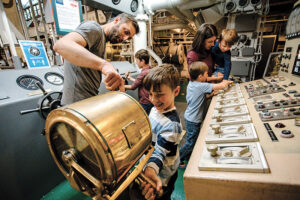 The National Museum of the Great Lakes’s stellar exhibits and activities — which include exploring the Col. James M. Schoonmaker museum ship from the cargo hold to the captain’s quarters — have already enticed many boaters to tie up in Toledo.
The National Museum of the Great Lakes’s stellar exhibits and activities — which include exploring the Col. James M. Schoonmaker museum ship from the cargo hold to the captain’s quarters — have already enticed many boaters to tie up in Toledo.
Now that the city is greener, more vibrant and focused on nature, and constantly developing new ways to have fun on the water, it’s certainly a go-to destination. So, set course for Toledo and experience its riverfront renaissance for yourself!
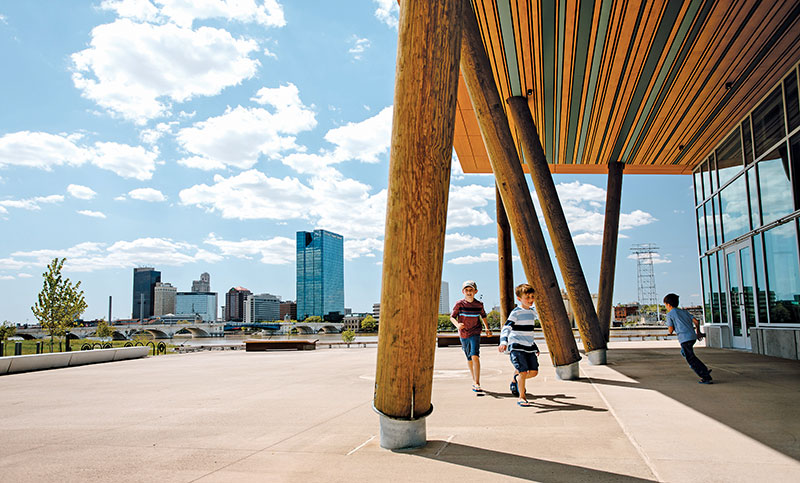
Photo Courtesy of Destination Toledo
Marinas and Yacht Clubs
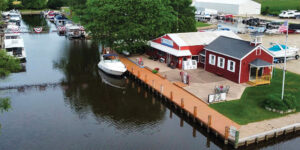
Anchor Pointe Marina: 419-836-2455; anchorpointe.org
Bay View Yacht Club: 419-729-0731; bvyc.org
Cooley Canal Yacht Club: 419-836-3500; cooleycanalyachtclub.org
Harbor View Yacht Club: 419-698-8128; toledoboating.com
Meinke Marina: meinkemarina.com
Toledo Skyway Marina: 419-407-9724; metroparkstoledo.com
Toledo Yacht Club: 419-726-3485; toledoyachtclub.com
Pictured: Anchor Point Marina
Photo Courtesy of Metroparks Toledo


